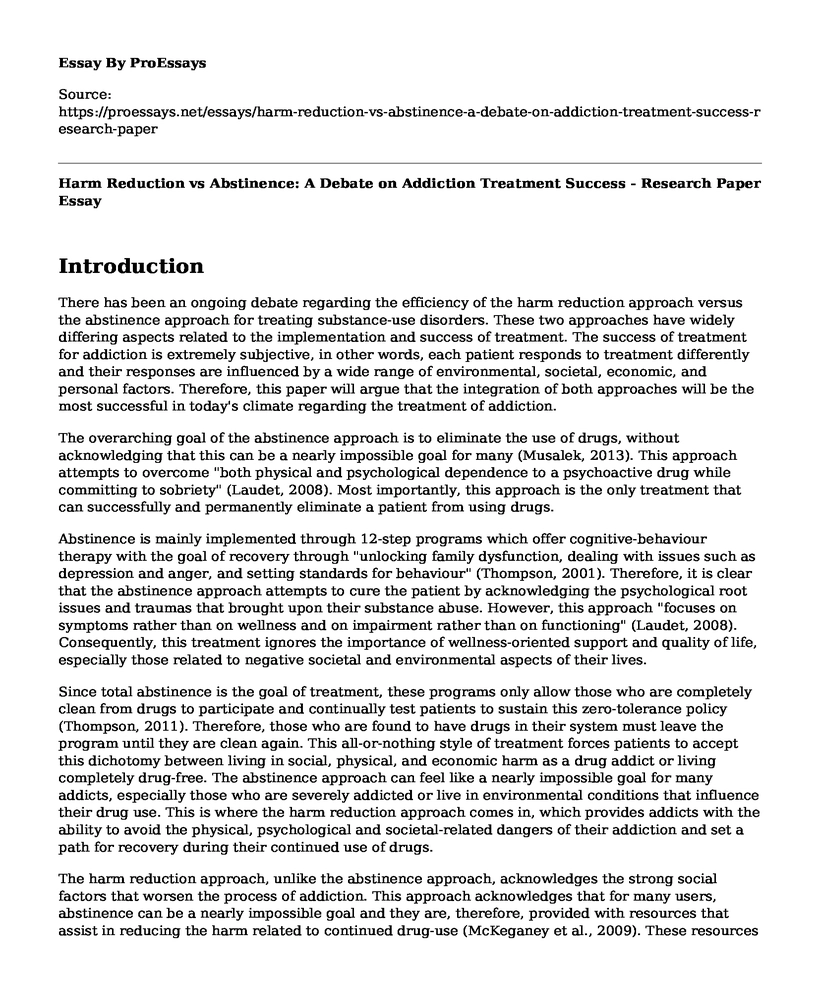Introduction
There has been an ongoing debate regarding the efficiency of the harm reduction approach versus the abstinence approach for treating substance-use disorders. These two approaches have widely differing aspects related to the implementation and success of treatment. The success of treatment for addiction is extremely subjective, in other words, each patient responds to treatment differently and their responses are influenced by a wide range of environmental, societal, economic, and personal factors. Therefore, this paper will argue that the integration of both approaches will be the most successful in today's climate regarding the treatment of addiction.
The overarching goal of the abstinence approach is to eliminate the use of drugs, without acknowledging that this can be a nearly impossible goal for many (Musalek, 2013). This approach attempts to overcome "both physical and psychological dependence to a psychoactive drug while committing to sobriety" (Laudet, 2008). Most importantly, this approach is the only treatment that can successfully and permanently eliminate a patient from using drugs.
Abstinence is mainly implemented through 12-step programs which offer cognitive-behaviour therapy with the goal of recovery through "unlocking family dysfunction, dealing with issues such as depression and anger, and setting standards for behaviour" (Thompson, 2001). Therefore, it is clear that the abstinence approach attempts to cure the patient by acknowledging the psychological root issues and traumas that brought upon their substance abuse. However, this approach "focuses on symptoms rather than on wellness and on impairment rather than on functioning" (Laudet, 2008). Consequently, this treatment ignores the importance of wellness-oriented support and quality of life, especially those related to negative societal and environmental aspects of their lives.
Since total abstinence is the goal of treatment, these programs only allow those who are completely clean from drugs to participate and continually test patients to sustain this zero-tolerance policy (Thompson, 2011). Therefore, those who are found to have drugs in their system must leave the program until they are clean again. This all-or-nothing style of treatment forces patients to accept this dichotomy between living in social, physical, and economic harm as a drug addict or living completely drug-free. The abstinence approach can feel like a nearly impossible goal for many addicts, especially those who are severely addicted or live in environmental conditions that influence their drug use. This is where the harm reduction approach comes in, which provides addicts with the ability to avoid the physical, psychological and societal-related dangers of their addiction and set a path for recovery during their continued use of drugs.
The harm reduction approach, unlike the abstinence approach, acknowledges the strong social factors that worsen the process of addiction. This approach acknowledges that for many users, abstinence can be a nearly impossible goal and they are, therefore, provided with resources that assist in reducing the harm related to continued drug-use (McKeganey et al., 2009). These resources include "drug consumption rooms, needle and syringe programmes, non-abstinence-based housing and employment initiatives, drug checking, overdose prevention and reversal, psychosocial support, and the provision of information on safer drug use." (What is harm reduction?, 2019).
Conclusion
In conclusion, If both approaches to treatment were to be integrated, all the physiological, psychological and social factors that play a role in the pathogenic process" would be taken into account (Musalek, 2013) . Each patient struggling with an addictive disorder is at a different stage related to their drug abuse, making the effectiveness of treatment plans subjective to the individual. Therefore, reducing drug intake through harm reduction supports before resorting to abstinence for those in the later and more severe stages of their drug dependence can be far more efficient and avoid the dangers related to quitting substance-use in a 'cold-turkey' fashion (Mulsalek, 2013).
References
Futterman, R., Lorente, M., & Silverman, S. (2004). Integrating Harm Reduction and Abstinence-Based Substance Abuse Treatment in the Public Sector. Substance Abuse 25(1), 3-7.
Henwood, B. F., Padgett, D. K., & Tiderington, E. (2015). Provider views of harm reduction versus abstinence policies within homeless services for dually diagnosed adults. HHS Author Manuscripts 41(1).
McKeganey, N., Morris, Z., Neale, J., & Robertson, M. (2009). What are drug users looking for when they contact drug services: abstinence or harm reduction? Drugs: Education, Prevention and Policy 11(5), 423-435.
Musalek, M. (2013). Reduction of harmful consumption versus total abstinence in addiction treatment. Neuropsychiatry 6(3), 635-644.
What is harm reduction? (2019). Retrieved from https://www.hri.global/what-is-harm-reduction
Cite this page
Harm Reduction vs Abstinence: A Debate on Addiction Treatment Success - Research Paper. (2023, Feb 23). Retrieved from https://proessays.net/essays/harm-reduction-vs-abstinence-a-debate-on-addiction-treatment-success-research-paper
If you are the original author of this essay and no longer wish to have it published on the ProEssays website, please click below to request its removal:
- Research Paper on Sexual Assault and Sexual Abuse
- The Birth of Women Literature Paper Example
- Research Paper on Gambling and Its Effects in the United States
- Exploring Feminism & Women's Mass Media: Research Paper
- Community Violence: A Magnificent Font of Venomous Hassle - Essay Sample
- Adolescence & TDV: Monitoring Children in a Vulnerable Period - Essay Sample
- Essay Example on Mental Health & Gun Violence: Connecting the Dots







